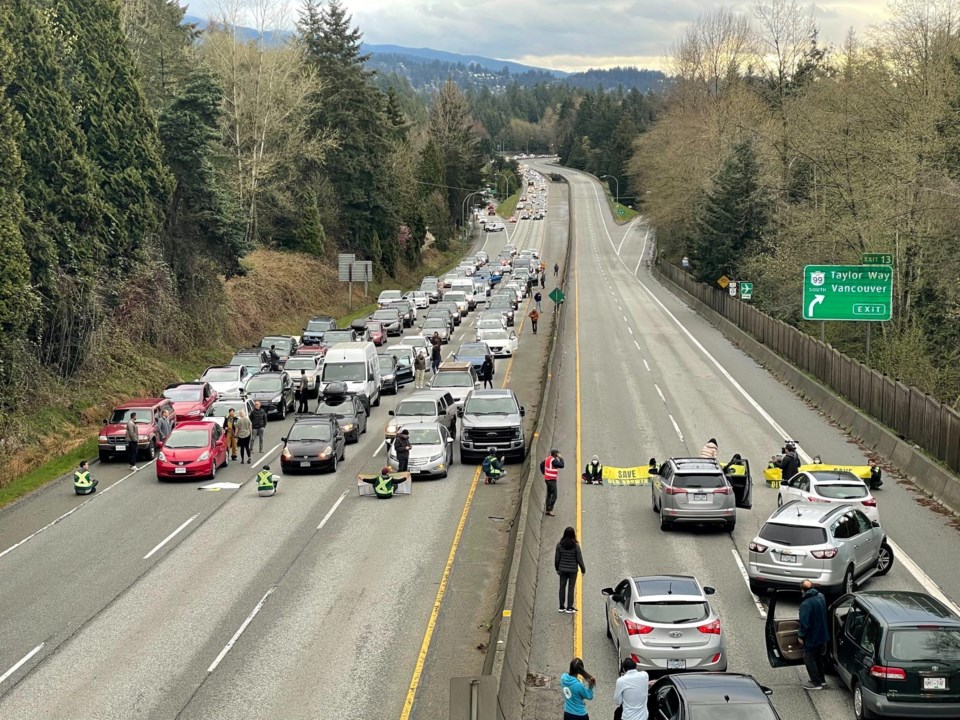For the third time this week, traffic on the North Shore was blocked by old-growth protesters, this time along Highway 1 in West Vancouver.
Around 8 a.m. on Friday morning (April 8), Save Old Growth protesters blocked the highway eastbound between Taylor Way and 15th Street.
The old-growth advocacy group have been blocking traffic on a rolling basis this week, with protests on Monday and Wednesday mornings snarling traffic along both the Ironworkers Memorial Second Narrows Crossing and the Lions Gate Bridge.
Both actions resulted in multiple arrests by police.
“We’re past signing petitions, writing letters and doing marches. The people in power have ignored these for decades. Unfortunately, that isn’t enough. At this time we all need to be entering into civil resistance,” Julia Torgerson, a spokesperson for Save Old Growth, said.
The group said actions will continue until the provincial government passes legislation to immediately end all old-growth logging in the province.
“This is on the government. Our collective future is being destroyed before our very eyes. As soon as the government passes legislation we will be off the highways. Until then, disruptions will continue,” Tim Brazier, who was arrested on the Lions Gate Bridge on Wednesday, said.
North Vancouver-Lonsdale MLA Bowinn Ma said she completely understands the passion that people bring to the table regarding old-growth protection, and she’d heard from countless people across the North Shore and British Columbia about the practice.
“For a long time, British Columbian governments have failed to protect the unique biodiversity that exists in our province,” Ma said. “And it's a big part of the reason why our government is working on implementing this new vision for B.C. forests, where our oldest and rarest forests are better protected, where Indigenous peoples are full partners in sustainable forest management, and where communities and workers are benefiting from secure and sustainable jobs for generations to come.”
Ma’s comments come off the back of a recently of old-growth forest from logging.
The announcement is the latest step after the . As of April 1, 75 First Nations, in partnership with the government, have agreed to the deferral, with more than 60 asking for more time to create deferral plans.
“But having said that, the work isn't done. There are 204 Nations in British Columbia, we've received responses from about 188 of them. … So this is an interim update. It is not the end of the work,” Ma said.
Ma said that while she wishes she could “wave a wand and instantly protect all old-growth, the reality is British Columbia was practically built on the forestry sector, and is very deeply integrated into our provincial and local economies, and the well-being of many communities and families are tied to it.”
Noting there’s a huge amount of work that goes into protecting the forests, including consulting with each and every First Nation, the government is providing millions in funding to communities affected by the deferrals.
“We're also looking to shift British Columbia's forestry sector from this volume based model that we've been under for so long, to a value based model. So, mass timber products, engineered wood products, those are the kinds of products that British Columbia can be a leader in providing that don't depend on large diameter trees,” She said. “The old forestry sector just depends so much on these large diameter trees in order to be economically viable, and that's just not sustainable.”
Ma said while deferrals may look like a temporary measure, the government is using them to immediately prevent further biodiversity loss while permanent solutions are developed.
“The deferrals are not the permanent solution, there's still more work that has to be done after the deferrals are put in place. But it gives us time and space that's needed to work with First Nations and local communities to develop these new long-term approaches to managing B.C. forests in a way that that is sustainable.
“We heard really loud and clear that First Nations want to be involved in old-growth management in their territories. And in many cases, this requires time to develop a strategy around it, like how it's going to impact their communities, and manage negative impacts and bring out the positive impacts,” Ma said.



